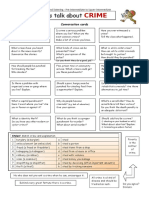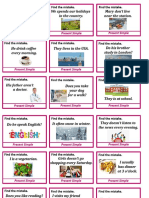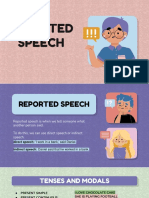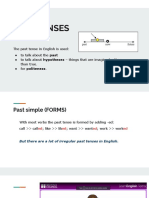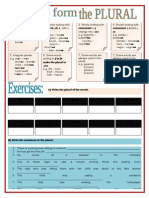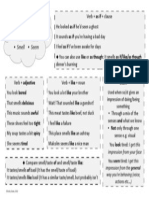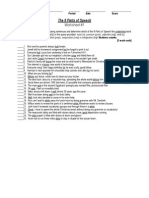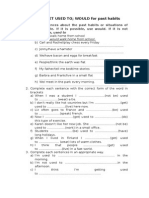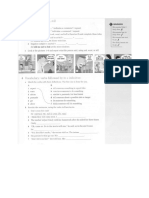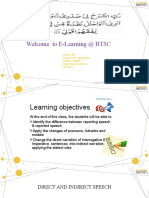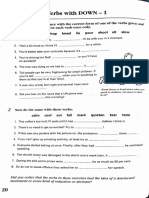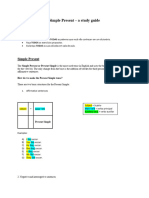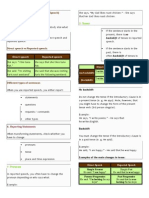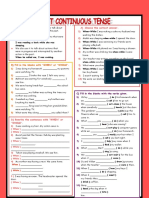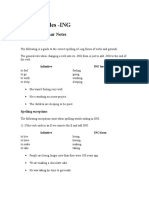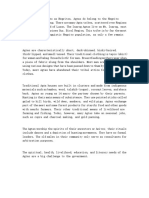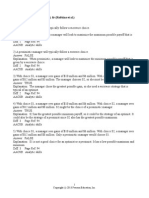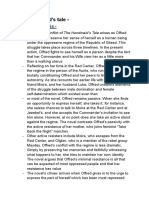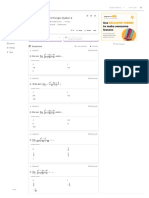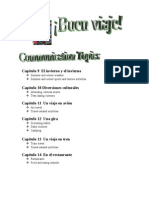Verb tenses: adding -ed and ing
The basic form of a verb is called the infinitive. It normally occurs with the word to as
in I want to askyou a question. Verbs may change their spelling according to which
tense is being used.
The past tense refers to things that happened in the past. To make the past tense of
regular verbs, the ending -ed is added to the infinitive ('I asked her a question').
The present participle refers to things that are still happening. To make the present
participle, the ending -ing is added to the infinitive ('I am asking her a question').
Often there's no need to make any other spelling changes when you add -ed and ing to the infinitive but there are some cases when it's necessary to do so. Here are
some rules to help you get it right:
Verbs ending with a silent e
If the verb ends with an e that isnt pronounced (as in bake or smile), then you need
to drop this final -e before adding -ed and -ing:
verb past tense present participle
bake baked
baking
smile smiled
smiling
Verbs ending in -ee, -ye, and -oe (such as free, dye, and tiptoe) do not drop the final
-e when adding -ing:
verb past tense present participle
free
freed
freeing
dye
dyed
dyeing
tiptoe tiptoed
tiptoeing
A very few verbs keep the final -e when adding -ing to distinguish them from similar
words. For example, singe becomes singeing rather than singing (which is the
present participle of sing).
Verbs ending with a vowel plus -l
�If the verb ends with a vowel plus -l (as in travel or equal), then you need to double
the l before adding-ed and -ing in British English:
verb past tense present participle
travel travelled
travelling
distil distilled
distilling
equal equalled
equalling
This rule doesnt apply in American English: see more information about the
differences betweenBritish and American spelling
Verbs ending with a single vowel plus a consonant
If the verb ends with a single vowel plus a consonant, and the stress is at the end of
the word (e.g.refer), then you need to double the final consonant before adding ed and ing:
verb
past tense
admit
admitted
commit committed
refer
referred
present participle
admitting
committing
referring
If the verb ends with a vowel plus a consonant and the stress is not at the end of the
word, you dont need to double the final consonant when adding -ed and -ing:
verb
past tense present participle
inherit inherited
inheriting
target targeted
targeting
visit
visited
visiting
If the verb has only one syllable and ends with a single vowel plus a consonant
(e.g. stop), then you need to double the final consonant before adding -ed and -ing:
verb past tense present participle
stop stopped
stopping
tap
tapped
tapping
sob
sobbed
sobbing
Verbs ending with two vowels plus a consonant
If the verb ends with two vowels plus a consonant, you should generally not double
the final consonant:
�verb
treat
wheel
pour
past tense
treated
wheeled
poured
present participle
treating
wheeling
pouring
Verbs ending in -c
If the verb ends in -c (e.g. panic), you need to add a -k before adding -ed and -ing,
and also -er.
verb
past tense
picnic picnicked
mimic mimicked
traffic trafficked
present participle
picnicking
mimicking
trafficking
related noun
picnicker
mimicker
trafficker
Spelling Rules -ING
English Grammar Notes
The following is a guide to the correct spelling of ing forms of verbs and
gerunds.
The general rule when changing a verb into its -ING form is just to add -ING
to the end of the verb.
Infinitive ING form
to feel
to go
to work
to sleep
feeling
going
working
sleeping
She wasn't feeling very well.
He is working on a new project.
The children are sleeping so be quiet.
Spelling exceptions
The following exceptions exist when spelling words ending in ING:
1). If the verb ends in an E we remove the E and add ING.
�Infinitive ING form
to live
to have
to make
to take
living
having
making
taking
People are living longer now than they were 100 years ago.
We are making a chocolate cake.
He was taking his time to get ready.
2). If the verb ends in a consonant + vowel + consonant, we double the final
consonant and add ING.
Infinitive ING form
to stop
to sit
to plan
to get
to swim
stopping
sitting
planning
getting
swimming
The policeman is stopping the traffic.
We are planning a surprise party for our teacher.
I think I am getting a cold.
3). If a two-syllable verb ends in a consonant + vowel + consonant, we do
not double the final consonant when the stress is on the first syllable.
Infinitive ING form
to happen
to enter
to offer
to suffer
happening
entering
offering
suffering
What is happening?
They are offering a discount.
Many people are suffering from a lack of food and water.
4). But, we do not double the final consonant when the verb ends in W, X or
Y or when the final syllable is not emphasized.
�Infinitive ING form
to fix
to enjoy
to snow
fixing
enjoying
snowing
He fixing his bike.
We are enjoying this great weather.
It's snowing outside.
5). If the verb ends in IE we change it to YING.
Infinitive ING form
to lie
to die
to tie
lying
dying
tying
I know you are lying to me!
You should water your plant more because I think it is dying.
The little boy is tying his shoelaces.
6). If the verb ends in consonant + vowel + L, we normally double the final L
and add ING.
Note: In the United States (US) they do not double the L when the accent is
on the first syllable.
Infinitive
ING form ING form
(UK)
(US)
to travel travelling traveling
to marvel marvelling marveling
I have been travelling around South America for 6 months.
He was marvelling at her beauty.
7). If the verb ends in a stressed vowel + R, we double the final R and add
ING.
Infinitive ING form
refer
defer
referring
deferring
Are you referring to this one or that one?
They are thinking of deferring payment of their mortgage.
8). If the verb ends in an unstressed vowel + R, we do not double the final
R and add ING.
Infinitive
ING form
to offer
offering
to suffer suffering
to whisper whispering
I am offering you a special deal.
He is now suffering the consequences of his actions.
I wonder what he is whispering in her ear.
Verb Forms and Verb Tenses (#6): Spelling -ing Forms, by Dennis Oliver
Verb Forms and Verb Tenses (#6):
Spelling - ing Forms
English verbs have five basic forms: the base form, the - S form,
the - ing form, the past form, and the past participle form.
There are several ways to spell -ing forms:
1.
If a verb ends in a stressed vowel + one or more
consonants + e or ue, "drop" the e and add - ing.
Examples:
abte / abating; ache / aching; bathe / bathing;
belive / believing; bite / biting; care / caring;
delte / deleting; dive / diving; enslve / enslaving;
excte / exciting; file / filing; gripe / griping;
hope / hoping; joke / joking; live / living;
make / making; parde / parading; paste / pasting;
raise / raising; revle / reviling; save / saving;
smoothe / smoothing; taste / tasting;
glue / gluing; rue / ruing; sue / suing
�2.
If a verb ends in - ie, change the - ie to - yand
add - ing.
Examples:
die / dying; lie / lying; tie / tying; vie / vying
3.
If a verb ends in y, add - ing. It doesn't matter if
there is a vowel or a consonant before y.
Examples:
pry / prying
spy / spying
4.
pray / praying
spay / spaying
If a verb ends in a vowel + one consonant,
double the consonant and add - ing.
Examples:
beg / begging; chat / chatting; dig / digging;
fit / fitting; grin / grinning; grip / gripping;
hop / hopping; mix / mixing; nip / nipping;
pin / pinning; quit / quitting; rip / ripping;
sit / sitting; tip / tipping; win / winning
5.
If a verb ends in a stressed vowel + r,
double the r and add - ing, but if a verb ends
in an unstressed vowel + r, do not double,
the r: just add - ing:
confr / conferring
defr / deferring
refr / referring
6.
nswer / answering
ffer / offering
sffer / suffering
If a verb ends in a vowel, add - ing.
Examples:
do / doing; echo / echoing; go / going; ski / skiing
7.
Add - ing to all other verbs.
___________________________________________
Special Notes:
�1.
Note that sometimes two consonant letters are
needed to spell a single consonant sound:
ache
bathe
breathe
cache
clothe
loathe
smoothe
wreathe
writhe
(In ache, the letters ch are pronounced k and in
cache, they're pronounced sh. The letters th are
pronounced like th in them.)
___________________________________
Notice also that sometimes two vowel letters are
needed to spell a single vowel sound:
achieve
believe
loathe
peeve
2.
The two words die and dye have the same sound (di)
but different spellings: die ('become dead') and
dye ('to color'). For die, the -ing form has i changing
to y before -ing is added. For dye, the -ing is added
after the e (which is not the normal pattern):
die ---> dying
3.
raise
receive
soothe
smoothe
dye ---> dyeing
The spellings vowel + consonants + e and
vowel + consonants show two different vowel
sounds. Notice that when - ing is added, the first
spelling drops the e and adds -ing, but the second
spelling doubles the consonant and adds -ing.
Examples:
file / filing
hope / hoping
mope / moping
tape / taping
Adding -ing/ed
fill / filling
hop / hopping
mop / mopping
tap / tapping
�Often we need to add -ing or -ed to a verb to make other forms
of the verb, for example:
I was talking when John arrived
Spelling Rule
Just add -ing or -ed to the end of the base verb:
work, working, worked
play, playing, played
open, opening, opened
Exceptions
(note: C=consonant; V=vowel)
If the base verb
ends in
and
add
do this
C + V + C and a
stressed syllable
double the final
consonant
C+e
remove e
ie
change ie to y
ing
lie, lying
die, dying
nothing
lie, lied
die, died
ing
ed
Examples
stop, stopping,
stopped
begin,
beginning
phone, phoning,
phoned
dance, dancing,
danced
make, making




